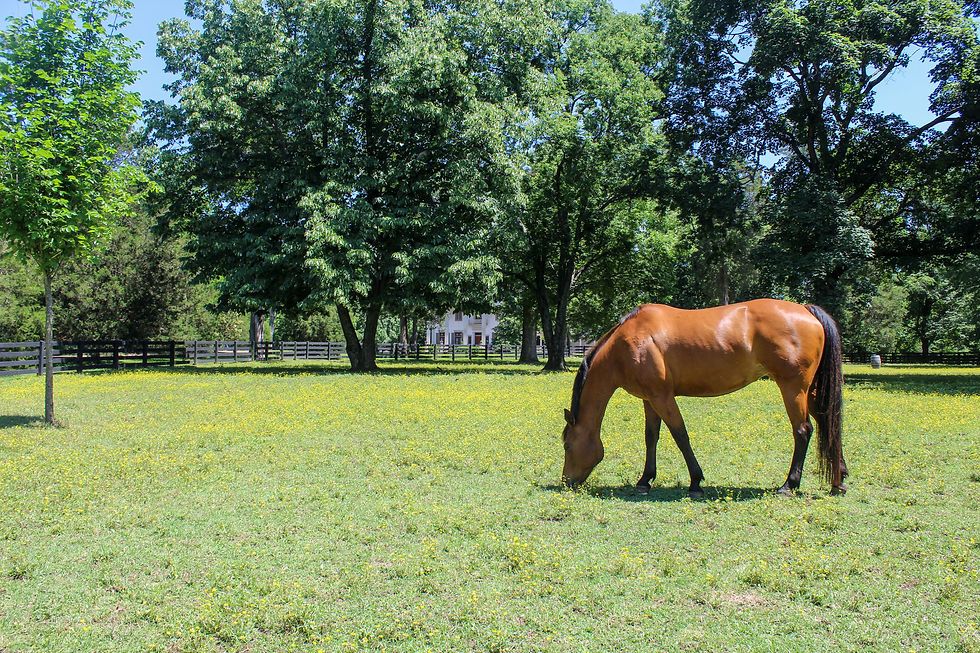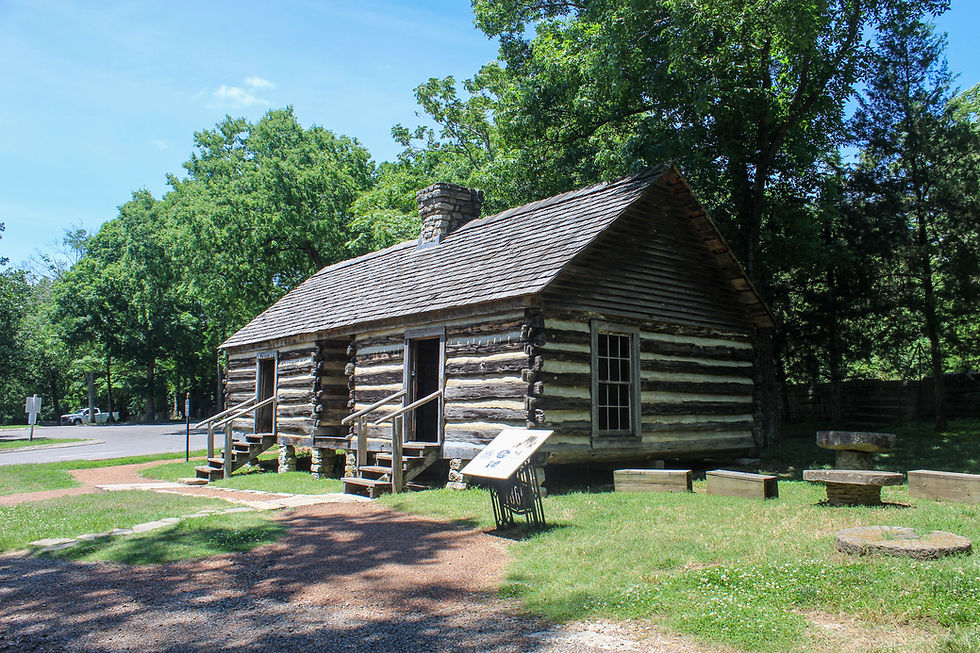Belle Meade Historic Site and Winery
- Tim Murphy
- Jun 4, 2023
- 7 min read
In February 1807, Virginia-born planter John Harding and his wife, Susannah Shute, purchased a 250-acre homestead seven miles south of Nashville, Tennessee. The property (originally named “Dunham’s Station”) was positioned along the Natchez Trace—an ancient Native American footpath utilized by settlers and frontiersmen traveling between Middle Tennessee and the Mississippi River. The highway’s proximity spurred Harding’s interest in commercial business ventures. By the mid-1810s, the Hardings operated a cotton gin, sawmill, gristmill, and blacksmith shop at their Belle Meade estate.
Harding was one of the first plantation owners in America to capitalize on the emerging popularity of horse racing. He initially boarded horses for prominent local residents (like Andrew Jackson) before graduating to racehorse breeding. Harding’s first sire to stand, Boaster, was advertised in the Nashville Whig to “let to mares at $25.00 in cash, or cotton at cash price, delivered at any gin in Davidson County.” In 1823, Harding registered his family’s maroon racing silks with the Nashville Jockey Club and trained horses at his racetrack in McSpadden’s Bend. By the mid-19th century, Belle Meade was recognized as Tennessee’s preeminent thoroughbred institution.

While racehorse breeding was certainly a lucrative undertaking, it paled in comparison to cash crop cultivation. In 1839, John Harding moved to Mississippi County, Arkansas, to tend his 10,000-acre Plum Point Bend cotton plantation, leaving his son, William Giles Harding, in charge of Belle Meade. William introduced selective breeding practices—improving the quality of his thoroughbreds—and expanded plantation landholdings to accommodate other high-quality livestock, such as Alderney cattle, Cashmere goats, and Cotswold sheep.
Livestock farming and cultivation were labor-intensive enterprises that required round-the-clock attention. Belle Meade exploited numerous enslaved individuals to satisfy these burdens and maximize profits. According to the 1860 Census, the Hardings owned 136 slaves across two Tennessee plantations, making them one of the largest slaveholders in Davidson County.
William Harding was an ardent supporter of the Confederacy. When Tennessee seceded from the Union in June 1861, he donated $500,000 to the Confederate Army. For his contribution, Harding was appointed Brigadier General and placed in charge of the Nashville Munitions Factory. When the city fell to Union forces in February 1862, William, along with several other Confederate sympathizers, were arrested and held as political prisoners at Fort Mackinaw, Michigan.
While William was detained, his second wife, Elizabeth Irwin McGavock Harding, managed the plantation. She also appealed to Tennessee’s military governor (and future president) Andrew Johnson to protect her family’s interests. Johnson obliged and stationed two Union sentries at Belle Meade to safeguard the property. Harding was released from prison on September 25, 1862, after paying a $20,000 bond and reciting an oath of allegiance. He remained under house arrest for the remainder of the war.
During the Battle of Nashville in December 1864, a small skirmish transpired on the plantation racetrack. Union soldiers of the 12th Tennessee Cavalry ambushed a Confederate supply train passing along the Natchez Trace, seizing fourteen wagons and forty-three rebel prisoners. A small detachment of Southerners under Lieutenant James Dinkins attempted to recapture their supplies and comrades, but were quickly driven off by the superior Federal force. Several bullet holes still speckle Belle Meade’s front columns to this day—permanent reminders of America’s bloodiest war.

After the Civil War, many of Harding’s former slaves remained at Belle Meade as sharecroppers. Harding agreed to supply his residing workforce with “quarters, fuel, sufficient and healthy rations of meal and meat, and to pay in money each one the sum agreed to by the parties.” Harding paid his most efficient employees twelve dollars per month, which was well above the immediate postbellum average of sixty dollars per year. However, contract laborers were subject to numerous pay deductions, including neglect of duty, property damage, abuse of livestock, and sickness. One of Harding’s former slaves, Robert Green, played an integral role in restoring Belle Meade’s prestige as a thoroughbred stud farm. Green, who worked as Belle Meade’s head hostler, was recognized by many in the racing industry as Tennessee’s foremost authority on thoroughbred breeding.
Beginning in 1867, Harding hosted annual yearling sales at his estate, attracting thousands of visitors from across the country. In 1868, former Confederate general William Hicks Jackson married Harding’s daughter, Selene, ushering in a new era of Harding-Jackson partnership at Belle Meade. In June 1871, the family purchased sire Bonnie Scotland—the progenitor of the American Triple Crown whose descendants comprise more than two-thirds of all Kentucky Derby winners.
During the spring of 1881, two representatives of the French government—Baron Favoret de Kerbreck and Captain De La Chere—toured around the United States inspecting horses and breeding establishments. Following their visit to Belle Meade, the Frenchmen reported, “the best specimen of thoroughbred horse [were] found at General Harding’s [estate in Tennessee]…that surpassed anything in England or France.” By the time of William G. Harding’s death on December 15, 1886, Belle Meade was considered “America’s Greatest Stud.”
In 1886, Jackson purchased the stallion Iroquois, who garnered international fame after becoming the first American-bred horse to win the prestigious Epsom Derby in Surrey, England. Iroquois’s acquisition resulted in record attendance for Belle Meade’s 1887 yearling sale with over four thousand guests. While at Belle Meade, Iroquois stood stud alongside famed racing champions such as Enquirer, Great Tom, and Luke Blackburn.

The surging Temperance Movement, antigambling campaigns, and economic Panic of 1893 all contributed to Belle Meade’s waning affluence around the turn of the century. Perhaps the most destructive catalyst was the suicide of Albert Marks, Jackson’s son-in-law who oversaw Belle Meade’s financial affairs. On the morning of June 14, 1902, Marks walked into the Nashville American editor’s office, sat down, and shot himself in the head. Many speculated the tragedy was due to an episode of temporary insanity; however, it was later revealed that monetary mismanagement (and the impending consequences) contributed to Marks’s demise.
William Hicks Jackson passed away from chronic kidney disease in March 1903. A few months later, his son, 29-year-old William Harding Jackson, died from typhoid fever, leaving two-year-old William Harding Jackson Jr. the sole inheritor of Belle Meade. The back-to-back deaths, combined with the estate’s sizeable $90,000 debt, compelled the remaining family members to sell the stud business and associated assets. Ultimately, Belle Meade was sold out of Harding-Jackson family in 1906.
In 1938, the Belle Meade Land Company acquired most of the former plantation’s landholdings and developed a modern residential community, now incorporated as the independent city of Belle Meade, Tennessee. The mansion and its thirty surrounding acres were occupied by private owners until 1953, when the State of Tennessee bought the estate to ensure its continued preservation. Today, Belle Meade is maintained by the Association for the Preservation of Tennessee Antiquities and functions as one of Nashville’s most adored historic attractions.

Belle Meade features several historic and culinary tour options, but the most popular experience is the Mansion Tour. The original Belle Meade manor was constructed in the Federal Style by John Harding between 1819 and 1820. In 1853, William G. Harding modified and enlarged the existing structure to its current Greek Revival appearance. During its years of occupancy, Belle Meade welcomed the likes of Sam Houston, Grover Cleveland, William Howard Taft, and Theodore Roosevelt. Today, visitors may enjoy a guided tour of this historic estate—decorated in late-19th century fashion with many original furnishings and heirlooms—and discover the intriguing Harding-Jackson family history.
Upon completion of the tour, age-appropriate guests are escorted to Belle Meade Winery for a complimentary tasting experience. The winery—Nashville’s first, opening in 2009—features traditional Tennessee wines made from sweet Muscadine grapes, blackberries, and other native fruits. Visitors are welcome to take a glass on the self-guided walking tour and indulge in the estate’s historic grounds.
Adjacent to the winery are the Carriage House and Stables (c. 1892), which feature several refurbished buggies and numerous thoroughbred racing artifacts. The Smokehouse (c. 1826)—one of the largest in the South—towers behind the barns, having the capacity to smoke 20,000 pounds of meat per year. In the back corner of the property lies the Mausoleum, which inters five generations of the Harding-Jackson family.

At the northern end of the estate, a reconstructed, two-room Slave Cabin houses the Journey to Jubilee exhibit—detailing the sociocultural history of Belle Meade’s enslaved and later-emancipated individuals. Across from the slave cabin are the Dairy (c.1884) and reconstructed Icehouse. The dairy—built in the Gothic Revival style—was one of Belle Meade’s most profitable industries, second only to thoroughbred breeding. During peak production, its steam-powered churn produced nearly 240 pounds of butter per week. The Icehouse currently hosts tastings for Belle Meade Bourbon—a continuation of the estate’s storied (albeit brief) distilling history. The Belle Meade Distillery, formerly located in Bosley Springs, was established in the 1870s by John Sperry and Watson Wade, the latter a cousin of the Harding-Jackson family. In 1879, Sperry, Wade, & Co. was the largest distillery in Tennessee, producing over 10,000 barrels of “Belle Meade Bourbon” for nationwide consumption. Tragically, on August 30, 1885, a massive fire destroyed Belle Meade distillery, effectively ending onsite production. The distilling firm shuttered their doors in 1887 due to the effects of the Temperance Movement.
The final stop on the walking tour is the original Harding Cabin (c. 1807), which remained the Hardings’ primary residence until 1820. The cottage was later occupied by head hostler Robert Green and his family. The two-room structure is divided to depict the dichotomous interior arrangements possessed by the Harding and Green families.
With more than two hundred years of equestrian tradition, Belle Meade continues to exemplify its longstanding qualities of reputability and hospitality. The genesis of America’s prestigious thoroughbred lineage—with its influential history and relaxed social atmosphere—certainly deserves recognition as one of Tennessee’s most beloved cultural attractions.
Visit Belle Meade's official website for more about the historic site and monthly events
Check out the Filson Historical Society, Historical Marker Database, UNC Library, Society of Architectural Historians, Travel Addicts, and The Suitcase Sisters to learn more about the Harding-Jackson family and Belle Meade's legacy
Visit Thoroughbred Heritage and To the Post for more information about Belle Meade's prestigious pedigree
For more historical information about Belle Meade, read the following scholarly publications:
Gower, Herschel. “Belle Meade: Queen of Tennessee Plantations.” Tennessee Historical Quarterly 22, no. 3 (1963): 203–222.
Wills, Ridley. "Black-White Relationships on the Belle Meade Plantation." Tennessee Historical Quarterly 50, no. 1 (1991): 17-32.
Wills, Ridley. "The Eclipse of the Thoroughbred Horse Industry in Tennessee." Tennessee Historical Quarterly 46, no. 3 (1987): 157-171.



























